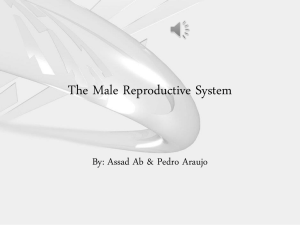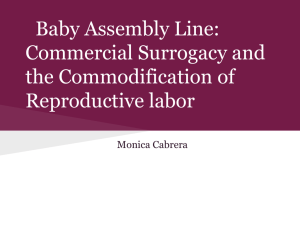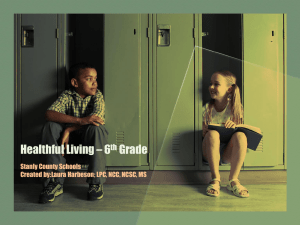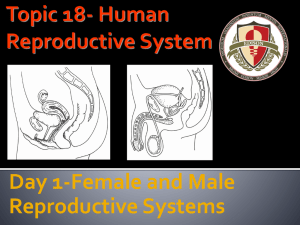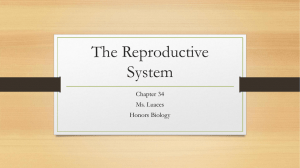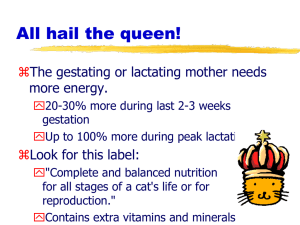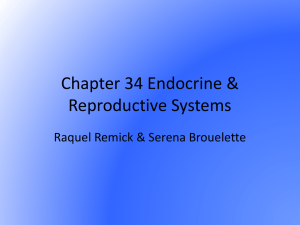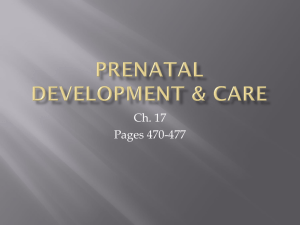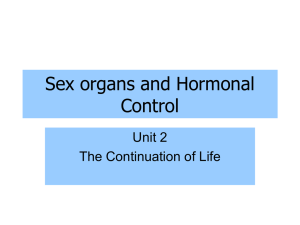Natural Animal Reproduction
advertisement
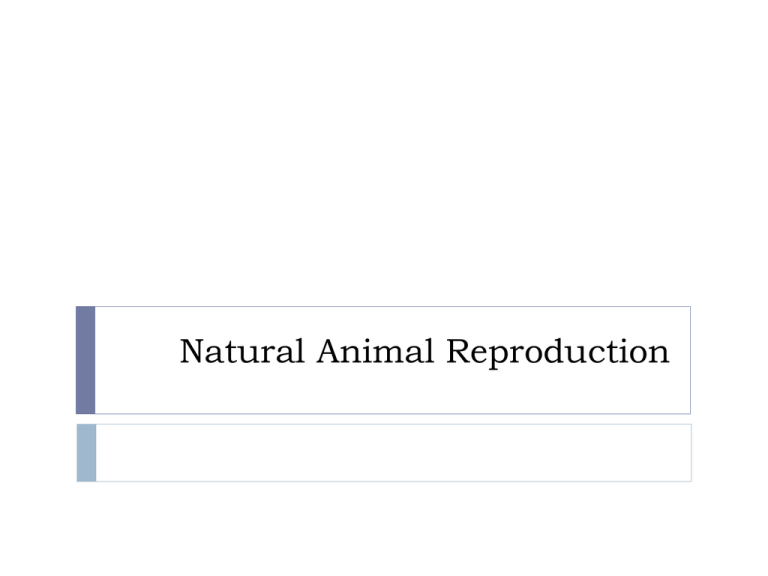
Natural Animal Reproduction What is Reproduction? Animal Reproduction Basics Reproduction The process by which offspring are produced. Offspring are of same species & have similar traits Not essential for an organism to live but is essential if a species is to stay in existence Animal Reproduction Basics Insemination Natural Insemination Placing of the sperm in the reproductive tract of the female. The process of the male depositing semen (fluid containing sperm) in the reproductive tract of the female. Occurs during copulation or mating Copulation The sexual union of a male and female animal Animal Reproduction Basics Artificial Insemination Involves a technician collecting semen from a male and placing it in the reproductive tract of a female http://www.youtube.com/watch?v=stvnGYcKz60 What are some Benefits of AI? http://www.youtube.com/watch?v=fmSSTueUhoQ Animal Reproduction Basics Breeding Is promoting animal reproduction so the desired offspring result. Reproductive Efficiency The timely and prolific replacement of a species. This is the difference between success and failure in animal production. Estrous Estrous Cycle The time between periods of estrus Estrous cycle of female mammals has four periods Cyclical expect during gestation or pregnancy (cattle or swine) Some animals are seasonal breeds and may go through periods of anestrus Anestrus The absence of cycling Often related to the number of hours of light in a day Examples: Sheep, cats, goats and horses Four Periods of the Estrous Cycle Estrus Also known as heat Period when the female is receptive to the male and will stand for mating Length varies between species Triggered by the hormone estrogen Changes that take place during estrus Restlessness Mucus discharge Swollen vulva Standing to be ridden by other animals Ovulation takes place during estrus for most species Ovulation-when a mature ovum is released by the ovary Four Periods of the Estrous Cycle Metestrus Ovulation occurs during metestrus in cattle and goats. The luteinizing hormone triggers the corpus lutea to develop from follicular tissue that remains after the release of the ova Four Periods of the Estrous Cycle Diestrus Period in the cycle in which the system assumes pregnancy. Fully functional corpus luteum releases high levels of progesterone. Progesterone-hormone that maintains pregnancy Uterus is prepared for pregnancy Four Periods of the Estrous Cycle Proestrus Begins with the regression of the corpus luteum and a drop in the hormone progesterone Changes in behavior may occur as estrus approaches What is fertilization? Fertilization The union of a sperm and an egg. The “roadmap” for fertilization is different between mammals based upon their reproductive tract. Process begins by male mammal depositing sperm in female mammal’s reproductive tract during mating. Fertilization Continued After sperm is deposited, sperm gradually travels through the female’s reproductive tract until it reaches the infundibulum (where ovum rest during ovulation) Sperm cell pierces an egg cell if present Only one sperm cell may fertilize an egg cell Crucial to time the presence of eggs cells and live sperm cells in a mammal. After an egg cell is released in a female mammal’s reproductive tract it has less than 12 hours to become fertilized by a sperm cell. Sperm cells cannot survive a long duration in a female mammal’s reproductive tract. What is a gestation period? Gestation After fertilization occurs gestation begins Gestation The period of time in which an animal is pregnant Gestation periods vary between species Gestation Process After fertilization occurs gestation continues as a series of cell divisions as the new animal (embryo) moves towards the uterus within 3-4 days. Embryo engages in rapid growth cycle called differentiation Develops major organs in the embryo After differentiation the new animals is known as a fetus Gestation Process Continued At this point fetus is surrounded by watery fluid enclosed in membranes Grows slowly in the uterus Fetus has an umbilical cord that is connected from its navel to the placenta, which lie along the wall of the uterus. Umbilical cord connection: Blood vessels that supply nutrients and oxygen to fetus Exit waste products The head, nervous system and blood vessels develop first Majority of the growth of the fetus occurs in the last stage of the gestation period. Parturition The process of a pregnant organism or animal giving birth to fetus Akalabor Three steps of Parturition 1. Start of uterine contractions and the reproductive organs prepare for the birthing process. a. b. c. 2. Abdominal muscular contractions occur and mother starts to pass the fetus. a. b. 3. Birth canal begins to open Female ‘s muscles begin to relax as fetus prepares to pass Fetus begins to align with the canal and the mother’s respiratory rate increases Fluid is released from the uterine body as lubricant. Stage concludes with the birth of the fetus. Expulsion of the placenta a. b. Mother's straining ends and she begins to relax Placenta detaches from the uterine wall and fetal membranes are released. Parturition http://www.youtube.com/watch?v=63rgERk2GQ&feature=related


